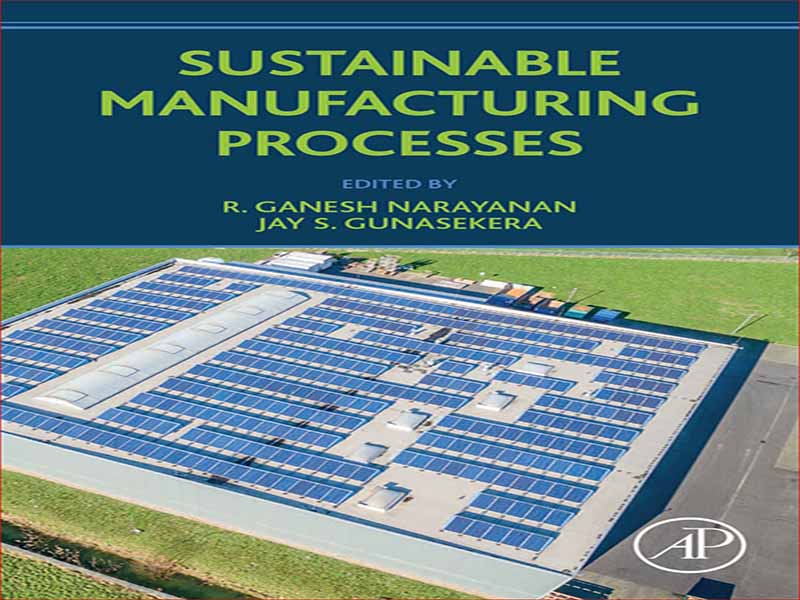- عنوان کتاب: SUSTAINABLE MANUFACTURING PROCESSES
- نویسنده: R. GANESH NARAYANAN
- حوزه: تولید پایدار
- سال انتشار: 2022
- تعداد صفحه: 370
- زبان اصلی: انگلیسی
- نوع فایل: pdf
- حجم فایل: 7.50 مگابایت
ریختهگری، شکلدهی، ماشینکاری و اتصال فلزات، فرآیندهای ساخت مهمی هستند که برای تولید انواع اجزای موجود در زندگی روزمره مورد استفاده قرار میگیرند. در حالی که این فرآیندها در چند دهه اخیر شاهد پیشرفتهای چشمگیری بودهاند، توجهی معادل به تولید پایدار صورت نگرفته است. تنها در سالهای اخیر، سیاستگذاران، ارگانهای دولتی، صنایع و دانشگاهها بر پایداری از طریق افزایش استفاده از انرژیهای تجدیدپذیر، ایجاد شیوههای پایداری، کاهش مصرف انرژی و مواد، کاهش انتشار ضایعات و پسابها و بازیافت زباله و آب مشارکت های تحقیقاتی نیز در این حوزه ها بهبود یافته است. ویراستاران کتاب چند سال پیش یک دوره ابتکاری جهانی شبکههای آکادمیک (GIAN) را با عنوان «شکلدهی و پیوستن به مواد سبز» ترتیب دادند، زیرا به اهمیت تولید پایدار اعتقاد داشتند. آنها همچنین یک گردهمایی دانشگاهی مربوطه را برای تسهیل بحث ها، به ویژه برای دانش آموزان، ترتیب دادند. این دوره جهت ویرایش کتاب فعلی در مورد فرآیندهای تولید پایدار را ارائه کرد. کتاب یازده فصل دارد. فصل اول با بحث در مورد اهمیت پایداری، اقدامات پایداری، نقش قدرت محاسباتی و صنعت 4.0 به مقدمه ای بر فرآیندهای تولید پایدار می پردازد. فصل دوم بر پایداری در صنعت ریختهگری و ریختهگری فلز تمرکز دارد و بر پایداری محیطی با در نظر گرفتن جنبههای مهم صنعت تاکید میکند. فصل سوم درباره «شکلدهی و اتصال مواد پایدار» است که ابتکارات پایدار در شکلدهی مواد و تحولات اتصال و جوشکاری در تولید پایدار را برجسته میکند. فصل چهارم به روشهای مختلف بهبود ماشینکاری برای تولید پایدار با استفاده از سیالات برش مناسب، افزایش عمر ابزار و کاهش سایش ابزار و اعوجاج قطعه کار میپردازد. فصل پنجم خلاصه ای از تکنیک های مختلف پردازش مواد پایدار همراه با مطالعات موردی را ارائه می دهد. در فصل ششم، استفاده و توسعه فرآیندها، سیستم ها، سازمان و ابزارها در فرآیند توسعه محصول مورد بحث قرار گرفته است. فصل هفتم به یک مطالعه موردی در مورد ساخت پایدار مواد فلزی ساختاری متخلخل فوق سبک با روش متالورژی پودر می پردازد. روشهای متداول برداشت انرژی زباله با بیشترین پتانسیل برای اتخاذ در فرآیندهای تولید پایدار با هدف بهبود بهرهوری انرژی، همراه با استراتژیهای مبتنی بر بهینهسازی مرسوم در فصل هشتم گزارش شده است. ارزیابی پایداری برای تعیین کمیت پایداری در صنایع از اهمیت بالایی برخوردار است. در این جنبه، فصل نهم ارزیابی عملکرد پایداری را با استفاده از رویکرد مبتنی بر خاکستری توضیح میدهد. برخی از پیشرفت های اخیر در زمینه تولید مواد افزودنی در فصل دهم ارائه شده است. فصل آخر مروری کوتاه بر تکنیکهای مهندسی به کمک رایانه برای نشان دادن اهمیت آن در تولید پایدار با کمک مطالعات موردی صنعتی ارائه میکند. نویسندگان منظره ای از موضوعات انتخاب شده ارائه کرده اند. با مراجعه به پایگاه داده مرجع گسترده ارائه شده در فصول می توان به درک عمیق بیشتری دست یافت. نویسندگان و ویراستاران در ارائه مفاهیم و تصدیق منابع اصلی دقت زیادی داشته اند. ما معتقدیم که متخصصان دانشگاه و صنعت از این کمک ها قدردانی خواهند کرد. خوانندگان تشویق می شوند تا هر گونه بازخورد سازنده را برای بهبود بیشتر ارائه دهند.
Metal casting, forming, machining, and joining are important manufacturing processes used to produce a variety of components existing in daily life.While these processes have seen significant developments in the last several decades, equivalent attention has not been provided toward sustainable manufacturing. Only in recent years has some emphasis been provided by policy makers, government bodies, industries, and academia on sustainability through enhanced use of renewable energy, establishment of sustainability practices, reduction in energy consumption and materials, reduction in emissions of wastes and effluents, and recycling of wastes and water. Research contributions have also improved in these domains. The editors of the book organized a Global Initiative of Academic Networks (GIAN) course on “Green Material Forming and Joining” some years ago because they believed in the importance of sustainable manufacturing. They also organized a corresponding academic gathering to facilitate discussions, especially for students. The course provided the direction to edit the current book on Sustainable Manufacturing Processes. There are eleven chapters in the book. The first chapter deals with an introduction to sustainable manufacturing processes by discussing the importance of sustainability, sustainability measures, the role of computational power, and Industry 4.0. The second chapter focuses on sustainability in foundry and metal casting industry, emphasizing environmental sustainability with consideration for industry important aspects. The third chapter is on “Sustainable material forming and joining,” which highlights the sustainable initiatives in material forming, and the developments in joining and welding in sustainable manufacturing. The fourth chapter deals with various methods of improving machining for sustainable manufacturing by the use of suitable cutting fluids, enhancing tool life, and reducing tool wear and workpiece distortion. The fifth chapter provides a summary of various sustainable material processing techniques accompanied by case studies. In chapter six, the use and development of processes, systems, organization, and tools in the product development process are discussed. The seventh chapter deals with a case study on sustainable manufacture of ultra-lightweight structurally porous metallic materials by powder metallurgy route. The common waste energy harvesting methods with the most potential to be adopted in sustainable manufacturing processes aims to improve energy efficiency has been reported in chapter eight, along with conventional optimization-based strategies. Sustainability assessment is of paramount importance to quantify sustainability in industries. In this aspect, chapter nine accounts for sustainability performance evaluation using grey-based approach. Some of the recent developments in the field of additive manufacturing is presented in chapter ten. The last chapter provides a brief overview of computer-aided engineering techniques to demonstrate its importance in sustainable manufacturing with the help of industrial case studies. The authors have provided bird’s-eye view of the chosen topics. Further in-depth understanding can be gained by referring to the extensive reference database provided in the chapters. The authors and editors have taken great care in presenting the concepts and acknowledging the original sources. We believe that academia and industry experts will appreciate the contributions. Readers are encouraged to provide any constructive feedback for further improvement.
این کتاب را میتوانید از لینک زیر بصورت رایگان دانلود کنید:
Download: SUSTAINABLE MANUFACTURING PROCESSES

































نظرات کاربران